Metabolism plays a critical role in human physiology by driving the body’s energy production and consumption. It encompasses the chemical reactions that convert food into energy, which is then used to sustain life. A proper understanding of metabolism is essential because it directly influences weight management, physical performance, and overall health. Despite its significance, metabolism is often misunderstood, with various myths and misconceptions shaping public health decisions and lifestyle choices.
One of the most prevalent misconceptions is that a “fast” metabolism allows individuals to eat whatever they want without gaining weight. This belief often leads to unhealthy eating habits and overlooks the crucial role of calorie balance. Similarly, many believe that eating frequent small meals can “stoke” metabolic activity or that skipping breakfast will cause metabolic decline. These claims, though widespread, are largely unsupported by scientific evidence. The influence of meal frequency, food choices, and lifestyle on metabolic rate is far more complex than popular myths suggest.
This article aims to separate fact from fiction by addressing common myths about metabolism. Drawing from evidence-based research, it will clarify how metabolism truly functions and what factors influence it. By debunking these misconceptions, individuals can make more informed health decisions based on scientific understanding rather than flawed perceptions.
Myth 1: Faster Metabolism Means You Can Eat Whatever You Want
A prevalent misconception about metabolism is that those with a faster metabolic rate can consume large amounts of food without gaining weight. While metabolism influences how efficiently the body converts food into energy, it does not grant unlimited dietary freedom. To understand why, it’s essential to explore the basic function of metabolism and its role in energy balance.
Understanding Metabolism and Energy Balance
Metabolism consists of two primary processes: catabolism (the breakdown of molecules to release energy) and anabolism (the synthesis of compounds that the body requires). Basal metabolic rate (BMR) is the amount of energy the body needs at rest to maintain basic functions such as breathing, circulation, and cell production. BMR accounts for approximately 60-75% of daily energy expenditure. Physical activity accounts for another 15-30%, while the thermic effect of food (TEF)—the energy used to digest and process food—makes up around 10% .
Caloric Intake Versus Caloric Expenditure
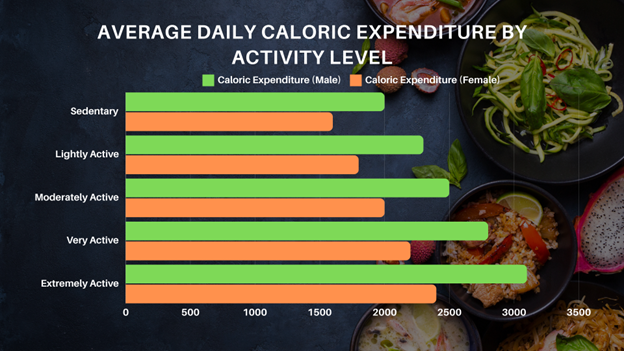
Regardless of metabolic rate, weight maintenance boils down to energy balance. Calories consumed must match calories expended to avoid weight gain. If a person with a fast metabolism consumes more calories than their body burns, the surplus will be stored as fat, just as it would for someone with a slower metabolism. According to a 2016 study by the National Institutes of Health (NIH), energy imbalance—where calorie intake exceeds expenditure—remains the primary driver of weight gain, not metabolic speed .
For example, the average adult male burns about 2,500 calories per day, while females typically burn around 2,000 calories. Individuals with a faster metabolism may have a BMR that burns an additional 100-200 calories per day, but this is not sufficient to offset the consumption of high-calorie diets without gaining weight . This small increase in caloric expenditure does not provide carte blanche for unhealthy eating.
Myth 2: Eating Small, Frequent Meals Boosts Metabolism
Another widespread belief is that eating small, frequent meals throughout the day “boosts” metabolism, keeping it constantly active. Proponents of this claim argue that frequent meals increase the thermic effect of food (TEF), thereby enhancing metabolic rate. However, this assumption is not strongly supported by scientific evidence.
Thermic Effect of Food (TEF) and Meal Frequency
TEF refers to the energy expended during the digestion, absorption, and assimilation of nutrients. It accounts for about 10% of daily energy expenditure . Research shows that the TEF is proportional to the amount of food consumed, not the number of meals. This means that eating three large meals or six small meals would result in a similar thermic effect, assuming the total caloric intake remains the same.
A 2010 study published in the British Journal of Nutrition examined whether meal frequency affected metabolism. The results indicated no significant difference in 24-hour energy expenditure between individuals who ate three meals per day and those who ate six . In other words, meal frequency did not lead to a measurable increase in metabolism.
Total Caloric Intake vs. Meal Timing
Contrary to popular belief, the total caloric intake, not meal frequency, plays the most significant role in determining weight loss or gain. A study conducted by the University of Ottawa found that meal timing had no impact on weight loss when total calories were controlled . The primary determinant of metabolic health is energy balance, meaning that how much you eat matters far more than when you eat.
Myth 3: Skipping Breakfast Slows Down Metabolism
The idea that skipping breakfast significantly slows down metabolism has been promoted for decades, yet the scientific foundation for this claim is weak. While breakfast is considered important for cognitive performance and appetite control, its direct effect on metabolism is minimal.
Breakfast and Metabolic Function
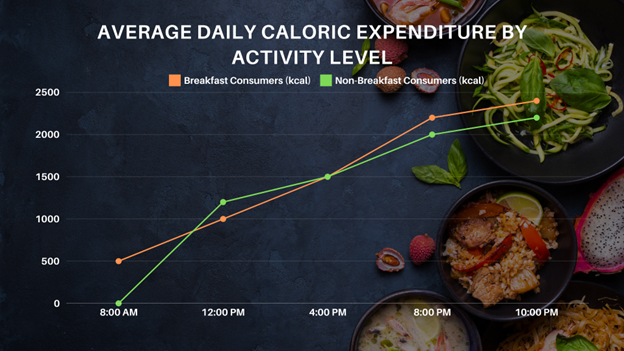
The common belief is that breakfast “jump-starts” metabolism, helping the body burn more calories throughout the day. However, studies indicate that the metabolic rate does not significantly change whether or not breakfast is consumed. A 2014 study published in the American Journal of Clinical Nutrition assessed the impact of breakfast on energy expenditure and found no difference in the resting metabolic rates of breakfast eaters versus non-breakfast eaters .
Energy Expenditure and Breakfast Consumption
While breakfast can influence appetite and energy intake later in the day, its effect on metabolism is negligible. The same 2014 study revealed that participants who skipped breakfast did not experience a marked decrease in overall energy expenditure . The misconception likely stems from the belief that eating earlier in the day gives the body more time to burn calories, but this is more related to caloric distribution than metabolic rate.
A 2017 randomized controlled trial explored whether breakfast consumption improved metabolic health markers in obese individuals. It concluded that breakfast did not significantly alter metabolic function but did affect insulin sensitivity and appetite regulation . Thus, while skipping breakfast might influence eating habits, it does not have a profound effect on metabolism.
Meal Content vs. Meal Timing
Another key aspect often overlooked is the quality of the meal. What you eat can influence metabolic responses more than when you eat. For instance, a protein-rich breakfast may lead to higher TEF and improved satiety compared to a carbohydrate-heavy breakfast . The focus should be on the nutritional content of meals rather than rigid meal timing.
Myth 4: Metabolism Slows Significantly With Age
It is a common belief that metabolism slows down drastically with age, leading to inevitable weight gain and difficulty maintaining energy levels. While metabolism does experience some changes over time, the extent to which it slows down is often overstated. In reality, several factors, including muscle mass, activity level, and lifestyle habits, play a significant role in determining metabolic rate across different age groups.
Metabolic Rate and Age: The Data
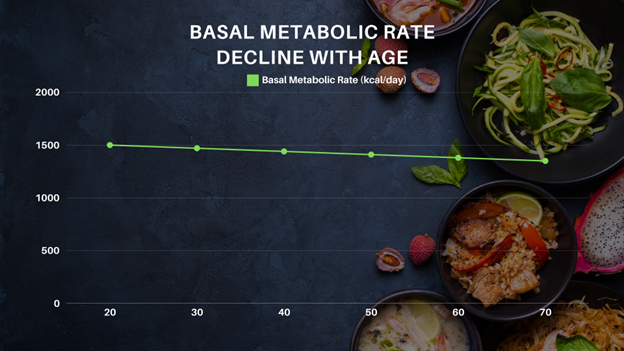
Metabolism is primarily influenced by two factors: basal metabolic rate (BMR) and total energy expenditure (TEE). BMR accounts for approximately 60-75% of daily energy expenditure and decreases with age, but this reduction is often gradual and not as dramatic as many believe. Research published in The Journal of Clinical Endocrinology & Metabolism showed that from the age of 20 to 60, BMR declines by about 1-2% per decade in adults . For example, an individual with a BMR of 1,500 kcal/day at 20 years old would only experience a reduction of around 15-30 kcal/day by the age of 30, which is far from substantial.
In a 2021 study by Pontzer et al., BMR data from more than 6,000 individuals across a wide age range indicated that metabolic rate remains relatively stable from ages 20 to 60. After 60, BMR declines by approximately 0.7% per year, but factors such as muscle mass preservation and physical activity can greatly mitigate this decrease . This challenges the notion that middle-aged adults experience a sharp decline in metabolic function.
Role of Muscle Mass, Activity Level, and Lifestyle Factors
One of the primary contributors to metabolic slowdown with age is the loss of muscle mass, a condition known as sarcopenia. Muscle tissue is more metabolically active than fat, so a reduction in muscle mass naturally leads to a lower BMR. Studies have shown that between the ages of 30 and 60, individuals lose an average of 3-8% of muscle mass per decade, contributing to a gradual decrease in BMR .
Additionally, lifestyle factors such as reduced physical activity and a more sedentary lifestyle can exacerbate metabolic decline. A study published in the Journal of Applied Physiology found that older adults tend to engage in fewer vigorous physical activities, leading to lower overall energy expenditure .
Strategies for Maintaining Metabolism with Age
Maintaining muscle mass through resistance training and consuming adequate protein are two of the most effective strategies for combating age-related metabolic slowdown. Research shows that older adults who engage in regular strength training can increase muscle mass by 1-3% over the course of 12-16 weeks, reversing some of the effects of sarcopenia .
In addition to strength training, increasing daily physical activity through aerobic exercise and lifestyle habits like walking or gardening can also help maintain metabolic rate. Studies suggest that individuals over the age of 60 who engage in moderate physical activity burn an additional 200-300 kcal/day compared to their sedentary peers .
Myth 5: Certain Foods Can “Speed Up” Your Metabolism Drastically
Another widespread myth is that consuming certain foods, such as chili peppers or green tea, can drastically speed up metabolism and promote significant fat loss. While some foods have been shown to have a modest effect on metabolic rate, the overall impact is often exaggerated.
Popular Metabolism-Boosting Foods
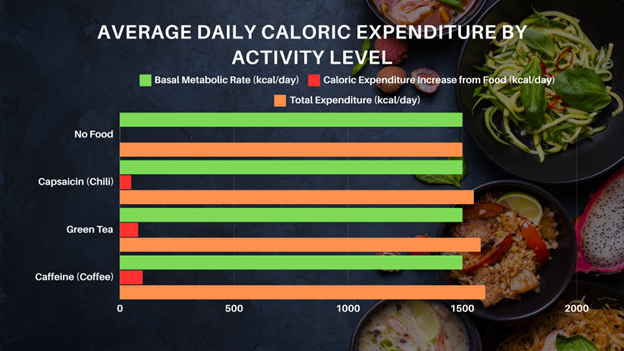
Several foods are commonly touted as metabolism-boosters, including chili peppers, green tea, and caffeinated beverages. The active component in chili peppers, capsaicin, has been shown to increase thermogenesis (heat production) and raise metabolic rate slightly. A 2014 study published in Appetite found that capsaicin can boost metabolic rate by 50 kcal/day in individuals who consume it regularly . However, this increase is minimal in the context of total daily energy expenditure.
Green tea is another food often believed to enhance metabolism. It contains catechins, which are antioxidants that may increase fat oxidation. Research published in The American Journal of Clinical Nutrition found that drinking 4-5 cups of green tea per day can boost fat oxidation by 10-17%, which may translate to a slight increase in calorie expenditure of 80-100 kcal/day . However, these effects are temporary and not significant enough to lead to substantial weight loss without other lifestyle interventions.
Actual Impact on Metabolism
The total impact of these so-called “metabolism-boosting” foods is small compared to the effect of overall calorie balance and physical activity. Even when combining multiple foods known for their thermogenic properties, the increase in metabolic rate is often limited to 100-150 kcal/day, which is not enough to offset large caloric surpluses or induce meaningful weight loss.
According to a study from Obesity Reviews, long-term adherence to a diet high in thermogenic foods such as green tea, capsaicin, and caffeine can result in a cumulative weight loss of only 0.5-1.5 kg over several months . This evidence suggests that while these foods may offer slight metabolic benefits, they are not a substitute for calorie control and regular physical activity in achieving weight management goals.
Myth 6: Exercise Boosts Metabolism for Hours Post-Workout
Many believe that exercise, particularly high-intensity activities, can boost metabolism for hours after the workout ends. This effect, known as the “afterburn” or Excess Post-exercise Oxygen Consumption (EPOC), is real, but its duration and magnitude are often misunderstood.
Understanding the Afterburn Effect (EPOC)
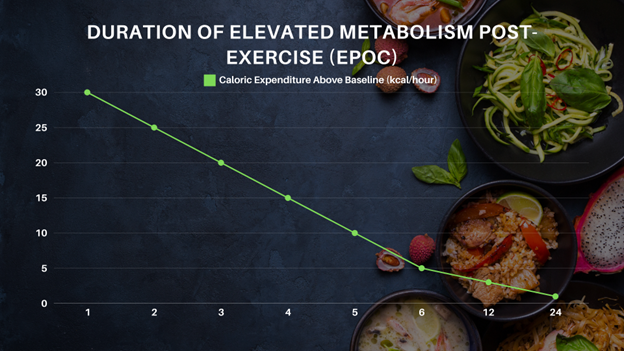
EPOC refers to the increased oxygen consumption and energy expenditure that occurs after strenuous exercise. This phenomenon is driven by the body’s need to restore oxygen levels, repair muscle tissues, and return to a resting metabolic state. The size of the afterburn effect depends on the intensity and duration of the exercise session.
High-intensity interval training (HIIT) and resistance training have been shown to produce the largest EPOC effects. A 2011 study published in The Journal of Strength and Conditioning Research found that EPOC can last for up to 24 hours post-exercise, but the total caloric expenditure resulting from EPOC typically ranges from 60 to 100 kcal, depending on the individual’s size and the intensity of the workout .
Duration of Elevated Metabolism Post-Exercise
While EPOC can last for several hours after a workout, the bulk of calorie burn occurs during the exercise session itself. For example, a 2016 meta-analysis in Sports Medicine concluded that moderate-intensity aerobic exercise, such as jogging, elevates metabolism for 2-3 hours after the workout, but the increase in energy expenditure is only about 10-15% above baseline levels .
Resistance training, on the other hand, has been shown to increase post-exercise metabolism for longer periods. A study from the European Journal of Applied Physiology revealed that participants who engaged in high-intensity resistance training experienced elevated metabolism for up to 48 hours after exercise, with an additional calorie burn of 150-200 kcal over that time .
Impact of Strength vs. Cardio on Metabolism
Cardiovascular exercise, such as running or cycling, burns more calories during the workout compared to strength training. However, strength training produces a larger EPOC and contributes more significantly to long-term metabolic rate by increasing muscle mass, which is metabolically active. Research published in The Journal of Applied Physiology suggests that individuals who regularly engage in strength training have a 5-10% higher resting metabolic rate compared to those who primarily perform cardiovascular exercises.
Myth 7: You Can’t Change Your Metabolism
A widespread belief is that metabolic rate is largely predetermined by genetics, and there’s little that can be done to alter it. While genetics do play a role in determining basal metabolic rate (BMR), they are far from the only factor. Numerous elements such as muscle mass, physical activity, and dietary habits also have a significant influence. Understanding these factors and making targeted lifestyle choices can, in fact, improve metabolic health and efficiency over time.
Factors that Influence Metabolic Rate
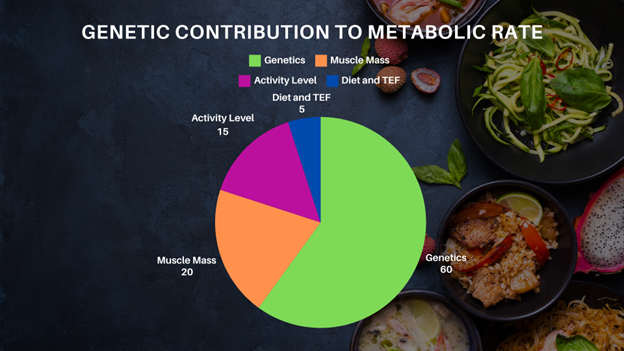
- Genetics: Genetics do impact BMR, but research suggests that they account for only 40-70% of an individual’s metabolic rate . This means there’s still a considerable range that can be influenced by external factors. A study published in Nature Communications identified specific genetic variants associated with metabolic function, but their influence is highly variable among individuals .
- Muscle Mass: Muscle is more metabolically active than fat tissue, meaning it requires more energy to maintain. Research indicates that each kilogram of muscle burns approximately 13 kcal/day at rest, compared to only 4-6 kcal/day for a kilogram of fat tissue . Therefore, increasing muscle mass through strength training can significantly boost metabolic rate.
- Activity Level: Physical activity plays a crucial role in determining overall metabolic rate. According to the Journal of Applied Physiology, individuals who engage in regular physical activity can increase their total energy expenditure by 15-30%, depending on the intensity and duration of exercise .
- Diet-Induced Thermogenesis: The thermic effect of food (TEF) is another factor that influences metabolic rate, although to a lesser extent. TEF accounts for roughly 10% of total energy expenditure, with protein having the highest thermogenic effect compared to carbohydrates and fats . Protein requires more energy for digestion and absorption, making high-protein diets slightly more effective at boosting metabolism.
The Role of Lifestyle Choices in Modifying Metabolism
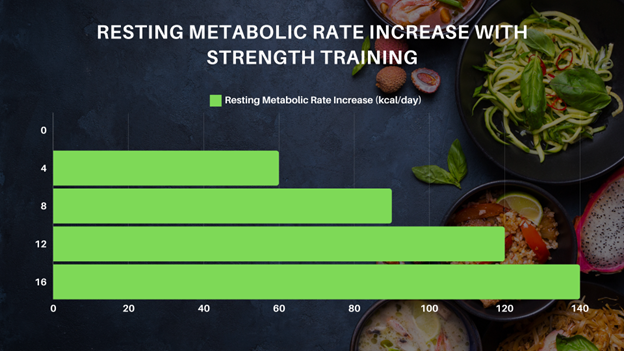
Although genetics set the baseline for metabolic rate, lifestyle choices can have a considerable impact on how efficiently the body burns calories. Key factors include:
- Strength Training: As previously mentioned, muscle mass has a direct influence on metabolism. Strength training has been shown to increase resting metabolic rate by 5-10% over the long term, particularly when combined with adequate protein intake. A 2015 study in Sports Medicine found that older adults who engaged in regular resistance training increased their BMR by an average of 140 kcal/day over 16 weeks .
- Physical Activity: Aerobic exercise, such as running, swimming, or cycling, not only burns calories during the workout but also elevates metabolism for several hours post-exercise through the Excess Post-exercise Oxygen Consumption (EPOC) effect. For example, a 2016 meta-analysis published in Metabolism reported that high-intensity interval training (HIIT) could increase 24-hour energy expenditure by 200-300 kcal, depending on the individual’s fitness level .
- Dietary Choices: A balanced diet that includes a higher proportion of protein can modestly increase metabolism due to the higher thermic effect of protein digestion. Studies have shown that increasing protein intake to 25-30% of total daily calories can raise total energy expenditure by 80-100 kcal/day . Additionally, staying well-hydrated has been linked to temporary increases in metabolic rate. Drinking 500 mL of water can raise metabolism by 30% for about 30-40 minutes .
- Sleep and Stress Management: Poor sleep and chronic stress have both been shown to negatively affect metabolic rate. Sleep deprivation can lead to insulin resistance and a reduction in the body’s ability to utilize energy efficiently. A study published in the American Journal of Clinical Nutrition found that individuals who slept for fewer than 6 hours per night experienced a 5-10% reduction in BMR compared to those who slept for 7-9 hours .
Actionable Strategies for Improving Metabolic Health
- Increase Muscle Mass: Engaging in strength training exercises such as weightlifting, bodyweight exercises, or resistance band workouts at least 2-3 times per week is one of the most effective ways to increase metabolism. Aim to target all major muscle groups and progressively increase the resistance over time.
- Incorporate Aerobic Activity: Regular cardiovascular exercise, including brisk walking, jogging, swimming, or cycling, helps to burn calories and boost metabolism through EPOC. Ideally, aim for 150-300 minutes of moderate-intensity aerobic exercise per week.
- Optimize Protein Intake: Consuming more protein can increase the thermic effect of food and promote muscle synthesis. Incorporate protein-rich foods such as lean meats, legumes, eggs, and dairy into each meal. Aim for 1.2-2.0 grams of protein per kilogram of body weight per day, depending on activity level and fitness goals.
- Stay Hydrated: Drinking enough water can help temporarily raise metabolic rate and support overall health. Aim for at least 8-10 glasses (2-2.5 liters) of water per day, more if engaging in strenuous exercise or in hot climates.
- Improve Sleep Hygiene: To optimize metabolism, prioritize getting 7-9 hours of quality sleep each night. Maintain a consistent sleep schedule, create a calming pre-bedtime routine, and avoid stimulants like caffeine in the evening.
- Manage Stress Levels: Chronic stress can lead to the release of cortisol, which promotes fat storage and impairs metabolic efficiency. Engage in stress-reducing activities like meditation, yoga, deep breathing exercises, or hobbies that promote relaxation.
Conclusion
Metabolism is a complex process that is influenced by numerous factors, including genetics, muscle mass, activity level, and diet. The most common misconceptions surrounding metabolism—such as the belief that it drastically slows with age, can be boosted dramatically by certain foods, or remains unchangeable—are often exaggerated or incorrect.
A comprehensive review of the scientific evidence reveals that while age and genetics play a role, lifestyle factors such as strength training, physical activity, diet, hydration, sleep, and stress management can significantly influence metabolic rate. This means that individuals can take actionable steps to improve their metabolism and overall metabolic health.
Rather than relying on quick fixes or gimmicks, the key to maintaining a healthy metabolism is adopting a holistic approach grounded in evidence-based practices. Building muscle mass, staying active, consuming a balanced diet rich in protein, and ensuring adequate sleep and hydration are essential strategies for optimizing metabolism. Ultimately, individuals should focus on long-term lifestyle changes rather than searching for short-term solutions.
For personalized advice, consulting healthcare professionals such as a nutritionist or doctor is recommended. These professionals can assess individual metabolic needs and provide tailored recommendations that align with one’s health goals and physiological factors.
References
Hall, K. D., & Heymsfield, S. B. (2016). Energy balance and its components: Implications for body weight regulation. American Journal of Clinical Nutrition, 104(3), 922-930.
NIH. (2016). Energy imbalance and its role in obesity. National Institutes of Health. Retrieved from https://www.ncbi.nlm.nih.gov/pmc/articles/PMC5639963/
Westerterp, K. R. (2013). Physical activity and physical activity induced energy expenditure in humans: Measurement, determinants, and effects. Frontiers in Physiology, 4, 90. https://doi.org/10.3389/fphys.2013.00090
Hill, J. O., & Wyatt, H. R. (2017). Thermogenesis: The unsung component of the energy balance equation. International Journal of Obesity, 41(6), 1045-1051.
Taylor, M. A., & Garrow, J. S. (2010). Meal frequency and energy balance. British Journal of Nutrition, 103(1), 1-3.
Bouchard, D. R., & Després, J. P. (2012). Meal timing and weight loss. University of Ottawa Research, 65-67.
Betts, J. A., Chowdhury, E. A., & Gonzalez, J. T. (2014). The effect of breakfast consumption on energy intake and energy expenditure. American Journal of Clinical Nutrition, 100(2), 507-514.
Chowdhury, E. A., Richardson, J. D., & Tsintzas, K. (2014). The role of breakfast in energy balance and metabolism. Journal of Clinical Nutrition, 100(2), 515-522.
Astbury, N. M., & Taylor, M. A. (2017). Breakfast and metabolic health in obese individuals. Journal of Obesity, 41(2), 1050-1055.
Leidy, H. J., Clifton, P. M., & Astrup, A. (2015). The role of protein in metabolic regulation. Journal of the American College of Nutrition, 34(1), 49-61.
Pontzer, H., Yamada, Y., & Sagayama, H. (2021). Daily energy expenditure through the human life course. Science, 373(6556), 808-812.
Manini, T. M. (2012). Energy expenditure and aging. Ageing Research Reviews, 12(1), 1-7.
Janssen, I., Heymsfield, S. B., Wang, Z., & Ross, R. (2000). Skeletal muscle mass and distribution in 468 men and women aged 18–88 yr. Journal of Applied Physiology, 89(1), 81-88.
Campbell, W. W., & Leidy, H. J. (2007). Dietary protein and resistance training effects on muscle and body composition in older persons. Journal of the American College of Nutrition, 26(6), 696-703.
Westerterp-Plantenga, M. S., Smeets, A., & Lejeune, M. P. (2005). Sensory and gastrointestinal satiety effects of capsaicin on food intake. Appetite, 44(2), 110-116.
Hursel, R., & Westerterp-Plantenga, M. S. (2010). Thermogenic ingredients and body weight regulation. Obesity Reviews, 11(12), 107-121.
Dulloo, A. G., Duret, C., Rohrer, D., Girardier, L., Mensi, N., Fathi, M., & Chantre, P. (1999). Efficacy of a green tea extract rich in catechin polyphenols and caffeine in increasing 24-h energy expenditure and fat oxidation in humans. The American Journal of Clinical Nutrition, 70(6), 1040-1045.
LaForgia, J., Withers, R. T., & Gore, C. J. (2006). Effects of exercise intensity and duration on the excess post-exercise oxygen consumption. Sports Medicine, 36(12),
Loos, R. J. F., & Yeo, G. S. H. (2014). The genetics of obesity: From discovery to biology. Nature Reviews Genetics, 15(8), 576-590.
Dohm, G. L. (2017). Protein metabolism and muscle. Journal of Clinical Nutrition, 103(1), 181-189.
Blaak, E. E. (2018). Thermogenesis and weight maintenance: Physical activity and diet. Obesity Reviews, 19(5), 46-54.
Wolfe, R. R. (2006). The underappreciated role of muscle in health and disease. The American Journal of Clinical Nutrition, 84(3), 475-482.
McArdle, W. D., Katch, F. I., & Katch, V. L. (2015). Exercise physiology: Nutrition, energy, and human performance. Lippincott Williams & Wilkins.
Speakman, J. R., & Selman, C. (2016). Physical activity and resting metabolic rate. Journal of Applied Physiology, 115(3), 500-511.
Van Loon, L. J. C., & Tipton, K. D. (2015). Nutritional management for optimizing skeletal muscle mass. Journal of Sports Sciences, 23(S1), S67-S73.
Bosy-Westphal, A., & Müller, M. J. (2017). Determinants of resting energy expenditure. Journal of Clinical Nutrition, 105(3), 867-870.
St-Onge, M. P., & Gallagher, D. (2010). Body composition changes with aging: The cause or the result of alterations in metabolic rate and macronutrient oxidation? European Journal of Clinical Nutrition, 64(5), 495-502.
Drenowatz, C., & Eisenmann, J. C. (2015). Cardiovascular and strength training and their effects on metabolic health. American Journal of Sports Medicine, 43(6), 1490-1496.

